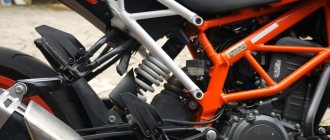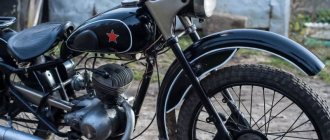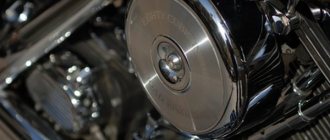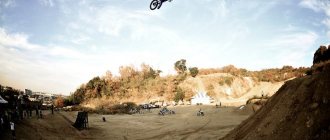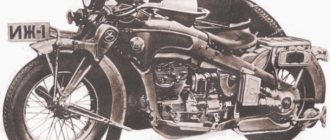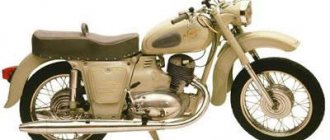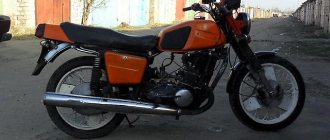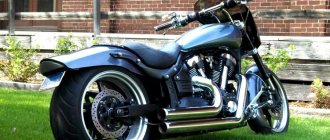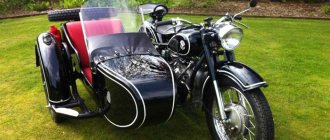MOTORCYCLE PHYSIOLOGY: METAL FRAMEWORK
Like toys on a Christmas tree, all the components and assemblies of a motorcycle are strung on a single base - the frame. The load-bearing function is the main one, but not the only one. The frame sets the geometric characteristics of the motorcycle, ensuring parallel movement of the wheels (not only statically, but also dynamically, due to its rigidity, resisting attempts to lead the wheels “astray”), setting the angle of the steering column (a parameter that directly affects handling - see "Moto", 2002, No. 3, p. 42). Since the design of the frame determines the layout of the machine, it directly affects the location of the center of gravity and center of mass.
It is clear that such an important component appeared simultaneously with the birth of the motorcycle. In fact, even earlier, since the bicycle served as the model for the chassis of the first motorcycle crews. An unexpected exception is the very first motorcycle in the world with an internal combustion engine - Gottlieb Daimler's Reitwagen, built in 1885. Even his contemporaries were shocked by the extremely archaic design of the wooden (!) chassis, copied not even from bicycles, but from their ancestors - scooter runners of the early 19th century. The current engineer is shocked by something else. The configuration of this frame is the same as that of modern sportbikes: two powerful elements running diagonally from the steering column to the rear wheel and covering all the most important components of the motorcycle.
But this is only an exception, and it is caused by the fact that Herr Daimler was not at all interested in the development of bicycle technology. The overwhelming majority of motorcycle creators of the late 19th and early 20th centuries quite adequately accepted both the bicycle frame design and the method of its manufacture (not by the usual electric welding, but by soldering). What attracted them? Firstly, proven production technology. Secondly, this classic design, formed by two tubular triangles, successfully combines low mass with high rigidity (flexural, but not torsional).
At first, motorcycle creators simply purchased frames from bicycle manufacturers and placed the motor either above the front or rear wheel, or inside the front “triangle”. But the center of gravity was too high. The solution was proposed by the Werner brothers, once Russian journalists, and at the turn of the 20th centuries - French inventors. In 1901, they received a patent for an open frame design: the pipes at the bottom are connected through the engine crankcase. Thus, the engine was located at the lowest point of the car, due to which the center of gravity was extremely low. The decision turned out to be so successful that literally a few months later similar motorcycles began to be made in both Europe and the USA! Some inventors went even further. Oscar Hedstrom on the first Indian motorcycle transferred the function of the frame's seat tube to the engine. The Englishmen Felon and Moore, on the contrary, inserted it instead of the front pipe - this solution was used on motorcycles of the company P&M (later Panther) founded by them until 1965!
Since then, motorcycle frames have been divided into two main types: closed, forming an unbroken contour, and open, including a power unit in their power structure. Each type has its own advantages. Closed frames are easy to repair and allow you to suspend the engine on silent blocks that effectively dampen vibration. In addition, the downpipes protect the crankcase from impacts. Open frames are significantly lighter, since part of the load is taken by the power unit (however, in this case the engine itself has to be strengthened, so the weight gain is not so great).
But in our times, when modern structural materials have emerged, it is not so important which type of frame to choose - closed or open. At the beginning of the twentieth century, metallurgy had not yet risen so high, and therefore, with increasing speeds, owners of motorcycles with open frames were afraid to see cracks appearing on the crankcases. Apparently, this is why such frames were abandoned already in the 1910s. Closed ones came to the fore, in which, to lower the center of gravity, the engine was located in a specially curved “loop”.
The increase in speeds has led to another problem. There was a lack of torsional (or torsion) rigidity, but this parameter directly affects handling (determines the ability of the wheels to follow the trail). Most designers followed the usual path: they began to increase the thickness and diameter (and thereby the mass) of the pipes. But someone came up with a better idea: add another triangle (it is the most rigid geometric figure). We will see this triangle in a duplex frame (front view) - the same one in which two pipes go down from the steering column. Another modification of this design is “half-duplex”: in it the front pipe bifurcates not at the steering column, but in the middle of its length.
The next breakthrough in “frame weaving” occurred in the 20s, and it was associated with the widespread use of stamping and pressing equipment. This led to the use of frames made of stamped parts joined by electric welding. Exotic designs also appeared, in which the frame was a monocoque stamped from steel sheets. And in conventional tubular frames, gussets and reinforcements are increasingly being used. Sometimes the top tube was stamped. But such technology became widespread only when electric welding replaced soldering - and this transition was completed only in the 50s.
But let's go back to the 20s. They brought another innovation that went virtually unnoticed at the time. The German Ardie tried to use a new material for frames - aluminum alloy. But the time of “winged metal” had not yet come.
A quarter of a century has passed, and again the end of the world war (this time - the second) and the associated surge in demand for motor vehicles spurred the imagination of designers. An engineer at the Italian concern Piaggio, Corradino D'Ascanio, developed the Vespa scooter in 1945 with a load-bearing steel body-cladding. This design was an order of magnitude superior in rigidity to conventional tubular scooter frames, so it is not surprising that they began to actively imitate it. Let us note such interesting cars of the 50s as the Italian Rumi Formichino scooter and the German Heinkel Perle moped: their monocoque body is made of aluminum alloy.
Another hit of the 50s was the spinal frame. It is based on a powerful spine (made of large-section pipe or stamped parts) connecting the steering column and the rear suspension pendulum mounting axis. Particularly successful was the variant of the ridge consisting of two stamped T-shaped halves connected by welding. They were installed in many German and Italian motorcycles of the 50s, the idea was borrowed by the Japanese, and they replicated the “ridge” in millions of copies. Compared to traditional closed structures, spinal frames are heavy, but cheap to manufacture. They often try to eliminate their inherent disadvantage - vibrations of a cantilever-mounted engine - by introducing a tubular coupler between the steering column and the front part of the crankcase.
But no one was going to throw traditional tubular frames into a landfill. Their lucky fate was helped by the brilliant invention of the Irishman Rex McCandless. He created a "fully duplex" frame, with dual downtubes and toptubes. In addition, the developer increased the rigidity of the steering column mounting when he ran the pipes crosswise: the upper ones to its lower part, the front ones to the upper part. And that's not all, the Irishman revolutionized the idea of good motorcycle handling. Previously, rigid short-travel suspensions were preferred, and the poor frame had to compensate for road unevenness due to its “compliance”. McCandless combined a very torsionally rigid frame with relatively soft long-travel suspensions. He offered his invention to the British company Norton. Its riders, having tried the new product, immediately gave it the nickname “featherbed”. Appearing on the tracks in 1950, 1-cylinder Norton motorcycles with a new chassis completely crushed the much more powerful 4-cylinder Gilera and MV Agusta! “Perina” became a model for the creators of both racing and powerful road equipment for 30 years to come.
But the “featherbed” also lost ground when the power of the motorcycles approached about. Therefore, in the late 60s and early 70s, racing motorcycle designers began to look for new solutions. At first they were attracted to monocoque box frames, made of steel or aluminum sheets or even fiberglass. In the late 70s, frames of the classical design, but made of rectangular aluminum pipes, became popular. But the most rational solution was found by the Spanish engineer Antonio Cobas. For the 1982 season, he prepared a motorcycle with a frame of a revolutionary design: it consisted of two powerful box-shaped elements made of aluminum alloy, running diagonally from the steering column to the axis of the pendulum. Thus the diagonal frame was born!
The ingenious design was soon picked up by all the creators of racing cars, and in the late 80s it was also adopted on production sports bikes. But the technology had to be adjusted.
Racing motorcycle frames are made like this: they knock out aluminum sheets to shape and weld (glue) them in several layers, and the number of these layers is greater where the frame experiences the greatest loads. The result is magnificent, but the method is extremely labor-intensive. In the manufacture of serial frames, cast parts are joined by welding with those obtained by stamping or by the extrusion method (the alloy is extruded through a matrix in a semi-hardened state). However, the latest advances in foundry make it possible to make frames entirely from cast parts (at the same time, it is possible to ensure everywhere that the thickness of the part is as required by the strength of materials).
The rigidity of the diagonal frame is additionally ensured by the power unit: it is usually closed through the cylinder head and the rear part of the crankcase. Sometimes subframes covering the engine are used. The “diagonal” is not always made of aluminum alloy. If we take a closer look at the welded steel tube birdcage frame that characterizes modern Ducatis, we see the same diagonal design. They tried to make frames for racing vehicles from carbon fiber. Alas, this option denies the possibility of quick changes adored by designers like “we’ll cut it here, weld it there.”
Aluminum alloys provide weight savings, but are less impact resistant than steel. Therefore, until the recent past, they were used only for road motorcycle frames. Nevertheless, progress is moving forward, and new brands of alloys with more and more “convenient” characteristics are appearing. They have allowed the Honda concern to use aluminum frames even for cross-country motorcycles since 1997. The frame of the CR and CRF series cars has pronounced diagonal elements, in addition, one of its elements is a subframe that covers the engine from below. The frame of the Honda XR650R enduro (debut in 1999) is designed differently: it has a classic design made of square aluminum tubes. In fact, Honda is ahead of the curve in its use of winged metal: we'll find aluminum frames on its X8R-S/X, Crea Scoopy, Giorno Crea, large Pan-European and Gold Wing touring bikes.
After everything that has been said about what an extremely important unit this is - the frame, I will stun you with the statement: a motorcycle can well... do without it. If the power unit is capable of absorbing part of the load, then why can’t it be made the main load-bearing element? This idea was successfully implemented back in the late 40s on English Vincent motorcycles, and today it is used on BMW boxer motorcycles. Of course, small subframes are necessary, without them it’s impossible. But these cars don’t have a frame as such at all! Rejected!
Drama frames
What to look for when choosing a motorcycle for a beginner?
When choosing a motorcycle, an important point is its technical characteristics. However, first of all, you need to consider a few important points:
- Height. A beginner needs to choose a motorcycle that allows him to place both feet on the ground when sitting on it. The dimensions of the vehicle must correspond to its owner.
- Weight. You can check if the motorcycle is the right weight by rolling it back and forth a few meters. First, this must be done while sitting in the saddle, then standing on the side.
- Landing. Sitting on a motorcycle should be comfortable. Particular attention should be paid to the position of the back and the tension of the arms.
- Color. This parameter is insignificant only at first glance. A beginner should give preference to a bright motorcycle so that it is clearly visible on the road.
- Price. It's better to start by buying an inexpensive motorcycle. A more respectable model should be chosen when sufficient experience has been accumulated.
What are the results?
The resulting homemade motocross motorcycle will not be able to compete with factory models, no matter how much you might want it to. However, there is a way to make it truly perfect - for this you need to select components that perfectly match each other, as well as fine-tune them, which can take months or even years. Additionally, a motocross bike with custom components will require more frequent maintenance—you'd be surprised how many problems can arise when riding a homemade machine. Therefore, it is worth considering the option of saving up for an inexpensive used foreign-made motorcycle. Moreover, purchasing high-quality components separately will also cost a considerable amount.
Engine as a stressed element
Further information: Motor under voltage
Harley-Davidson Model W with structural tubes bolted directly to the crankcase to complete the frame triangle
For rider comfort, the motorcycle engine can be mounted on rubber bushings to isolate vibration from the rest of the machine. This strategy means that the engine has little impact on frame rigidity, and that absorbing rather than dissipating vibration can cause damage to the frame, exhaust pipes and other live parts.[3]
Instead, if the engine is rigidly mounted to the frame, vibrations are transmitted and dissipated through the entire frame and rider. A rigid mount allows the engine to contribute to the overall frame rigidity. It also becomes possible to mount the swingarm directly to the engine rather than to the frame, eliminating the need for frame members to extend down to the swingarm's pivot point. By increasing the number of mounting points between the engine and frame, vibrations and stresses in the frame can be better dissipated, typically creating a triangle between the swingarm at the rear, the cylinder head at the top, and the lower crankcase at the front. If a rigidly mounted motor not only contributes to the rigidity of the frame, but is critical to it, and is an integral part of the closure of the triangular or lattice design that transfers force from the headstock to the swingarm to such an extent that without the motor the frame would be deformed, the motor called a tense penis
, or
raised engine
. Distributing the load between the engine and frame reduces the overall weight of the motorcycle.[3]
Voltage engines were first used at least as early as 1916 on the 1916 Harley-Davidson 8-valve racing machine. Harley-Davidson Model W by 1919.[23] This was called a cornerstone or diamond frame.[24][25] The 1946 Vincent B Series Rapide was designed with an improved chassis dubbed "the paragon of strength of its time",[26] this included a member-loaded engine. During early testing of the 1983 Kawasaki GPZ900R, twin downtubes were included, creating full support, but they were found to carry little load, so they were removed, relying entirely on the combination of steel frame and engine to provide chassis rigidity.[27]BMW's R1100 series The 1994 twins take the load completely off the frame as the engine carries all the load front Telelever fork rear Monolever.[28][29]
Rigidity
Frame stiffness is a concern for motorcycle designers as it is for motorcyclists. bicycle frames are the descendants of motorcycles.[30][31]
Factory frame stiffness can be modified to improve handling characteristics. This is often done by triangulating the factory frame.[30][32] Triangulation is a technique used in many engineering applications to impart rigidity to structures.[33] However, it can also have undesirable consequences if other parts of the frame are overloaded, since the flexible frame acts like a spring, absorbing some of the loads.[34]
Lateral stiffness
In the 21st century, advances such as high-horsepower engines driving high-grip tires[35] and more efficient suspension components, especially forks,[36] have meant designs with increased overall frame stiffness are available to consumers. Analysts disagree as to whether infinite lateral stiffness is desirable,[36] or whether a finite degree of built-in flexibility is preferable.[37][38]
Content
- 1 Materials 1.1 Steels
- 1.2 Aluminum
- 1.3 Carbon fiber
- 1.4 Magnesium
- 1.5 Titan
- 1.6 Composite
- 2.1 Spine or spinal column
- 4.1 Lateral stiffness
Recommendations
- Note: ...eg Ducati 900 SS
- Note. An example is Vincent HRD
- ^ a b c
Cocco 2004. - ^ a b
Clifford, Peter (1981),
Motorcycle Course 1983-1984.
, Hazleton Publishing Ltd, ISBN 0-905138-18-X , Revolutionary is an overused word, but this was the first time a carbon fiber frame had been built for Grand Prix competition. - Cathcart, Alan (January 2008), "ELF Racing - ELF Motorcycle Chassis Designs - A Retrospective; traces of a decade of radical experimentation with racing motorcycles", Motorcyclist
, p.50(6), ISSN 0027-2205, archived from the original on 2011-05-26, retrieved 2011-02-26 - “1971 titanium Husqvarna; the motorcycle they're capable of," The American Motorcyclist
, Westerville, OH: American Motorcyclist Association, vol. 60 ch. 11, p. 75, Nov. 2006, ISSN 0277-9358, retrieved 2011-02-26 - ^ a b
"Framing the Future: The Legacy of Antonio Cobas." superbikeplanet.com. Archived from the original on September 2, 2004. Retrieved December 14, 2010. - Walker, Mick (2002). Japanese Grand Prix racing motorcycles by Mick Walker
. Gateshead: Redline Books. paragraph 66. ISBN 978-0-9531311-8-1. - “Motorcycle Design in France,” Motorcycle, July 29, 1920, pp. 122–124.
- "1963 Ariel Leader". Archived from the original on 2009-01-15. Retrieved 2008-11-24.
- Brown 1991.
- Garson, Paul (May–June 2021). "Art Deco on Wheels: Majestic 1930." Classic motorcycles
. Retrieved October 6, 2021.CS1 maint: date format (communication) - Motorcycle
, two-page road test, March 7, 1957, pp. 298–299. Accessed June 15, 2021 - ^ a b c
Robinson, James (September 2001).
"Santiago Herrero - Spanish pilot." Classic Racer
(91): 35–40. ISSN 1470-4463. - "8W - Who? — Eric Offenstadt." Forix.autosport.com. Retrieved 2010-10-20.
- F750 race result iomtt.com. Retrieved December 27, 2019
- “Motorcycle technology – future perfect – at its best.” motorcyclistonline.com. Retrieved December 17, 2011.
- "Unconventional: Using a Shrimp Shell Frame." Calling the Honda Spirit
. Honda Motor Co., Ltd. Retrieved 2009-12-26. - "Aerobike". Britten motorcycle company. Archived from the original on 2009-06-15. Retrieved 2009-06-19.
- Kawasaki Technologies. Motorcycles and engines Kawasaki Heavy Industries. Archived from the original on January 12, 2021. Retrieved December 18, 2021.
- Anderson, Steve (January 2000). "GREEN". Bicycle World
. paragraph 34. Received December 27, 2021. - "Carbon fiber". Archived from the original on February 24, 2013. Retrieved February 16, 2013, Velocite-bikes.com
- Rafferty 2001.
- Hunt et al. 2012
- Abdo 2012.
- Field 2002.
- Walker 2006.
- Stermer 2006.
- Coombs and Shumark 2002.
- ^ a b
"Motorcycle Frame Explained - Framing Game",
Super Streetbike
, September 18, 2009 - Damon Rynard, Sheldon Brown (eds.), Rynard Frame Deflection Test
, Harris Cyclery, retrieved 2016-05-11 - Foal 2006.
- Enright 2015.
- Tony Foale (November 1987), Frame Mods
, Tony Foale Design, retrieved 2016-05-11 - Kevin Cameron (June 2004), "A Brief History of Chassis Flex", Bicycle World
,
43
(6), pp. 18 - ^ a b
James Parker (August 3, 2011), "Ducati Desmosedici RR: The 85 Percent Solution",
Motorcyclist
, Suspension components that allow less flex and uncontrolled wheel movement require fewer band-aids in the form of movement compensation in the chassis. - Parks 2015 “[M]otorcycle engineers design with 'tuned' chassis numbers and tire flexibility in mind. This is beneficial because at maximum lean, the frame and tire sidewalls are at a better angle to absorb road impacts than the suspension system.”
- Kevin Cameron (July 2006), "Woe Rossi", Bicycle World
,
45
(7), p. 18, [L] Lateral flex must now be specifically designed in chassis parts to complement suspension performance at high lean angles.
First attempts at modernization
A couple of decades after the appearance of the first motorcycle (remember, it was released in 1885), it became clear that standard models were not suitable for cross-country riding - they were too bulky and heavy. At the same time, the rules of the competition had not yet been clearly worked out, which gave enthusiasts a certain freedom, thanks to which they began to make the first changes to the design.
They mainly concerned lightening the vehicles to improve their maneuverability. To do this, the racers simply dismantled all the “extra” parts such as the trunk, passenger footrests and even headlights. The suspension underwent changes a little less frequently - they tried to make it stiffer so that the car would behave more predictably off-road, and some owners even worked on improving the engine, trying to achieve more power.
Preface.
Scott motorcycles are almost unknown in the CIS countries, and it is impossible to find sufficient information in Russian. In this regard, we have taken the liberty of making a small “guide” for those who want to understand the history of the brand and its technical details.
Depending on your goals, we suggest you read the entire article, or go straight to the description of the motorcycle “Motomira Vyacheslav Sheyanova”:
- History of the brand.
- Historical and technical details.
- Exhibit of the motorcycle museum “Motoworld of Vyacheslav Sheyanov”.
Mega Moto Chandelier
Good afternoon, dear visitors and community members.
I will present to you another joint creation.
A “blacksmith” I knew, seeing how I was suffering in the garage and doing all sorts of things, asked me to participate in the manufacture of a chandelier that was ordered for him. Project, sketch, materials, premises - his, welding, grinder, execution, time - mine.
Approximate parameters of the expected chandelier:
Height is about 2m, weight is about 260kg. The diameter of the lower rim is 110 cm.
The designer sketched out the layout in the rear
The layout was transferred to paper to determine the dimensions
I had a blacksmith shop at my disposal, and after my main job I had to learn new equipment at a new job.
Bottom wheel with dumbass
The wheels are overgrown with stars.
I had to bring the lower part of the rim visible to the eye to a perfectly smooth surface
I bent the electrodes and welded these hooks for the chains
Control assembly in the workshop, painting, installation of sockets inside the chandelier and wires
It will hang on these hooks, on the other side there is a 50x50cm plate
